Exploring Panfish Species: A Comprehensive Overview
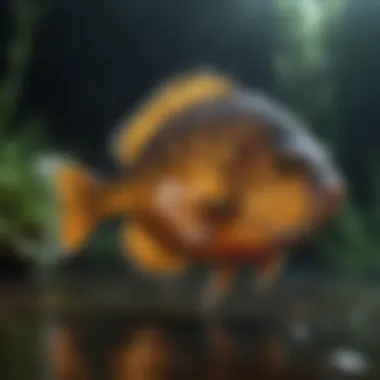
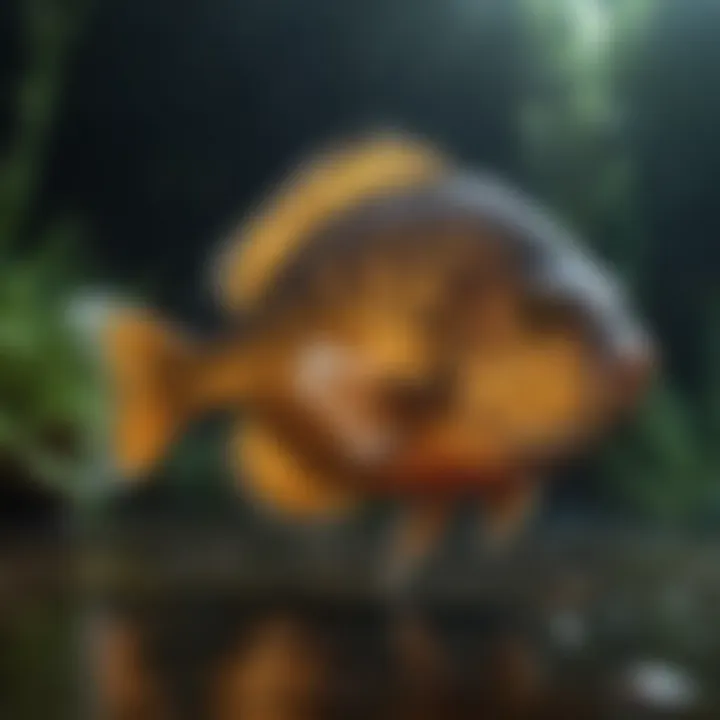
Overview of the Topic
Panfish species play a vital role in freshwater ecosystems, contributing to both biodiversity and the overall health of aquatic habitats. This article explores the key characteristics of these species, their ecological significance, and the environmental challenges they face. Understanding these elements is crucial for conservationists, students, and environmentalists who aim to protect freshwater ecosystems.
Panfish, often referred to as smaller game fish, include species such as bluegill, sunfish, and crappie. Their presence in ponds, lakes, and rivers is not just notable for fishing enthusiasts but also for the intricate web of life they support. As both prey and predator within their ecosystems, panfish contribute to a balanced food chain, ensuring nutrient cycling and energy flow.
Historically, the significance of panfish has been recognized in recreational fishing, yet their larger role in maintaining healthy aquatic environments often goes unnoticed. Local communities and economies benefit from sustainable fishing practices, which further underscores the necessity of understanding these species.
Current Status and Challenges
The current state of panfish populations varies greatly across regions. Some areas have witnessed a concerning decline in numbers, largely due to habitat degradation, pollution, and overfishing. Factors such as climate change introduce added stressors, altering water temperatures and affecting spawning cycles.
Key challenges include:
- Habitat Destruction: Urban development and agricultural runoff threaten the natural habitats of panfish. Wetlands, which serve as crucial breeding grounds, are often drained or polluted.
- Pollution: Contaminants, such as pesticides and heavy metals, accumulate in water bodies. These harmful substances affect the health of panfish and their ability to reproduce.
- Overfishing: Unsustainable fishing practices result in diminished populations, affecting not only panfish but also other species within their ecosystem.
"The interconnectedness of panfish populations with the broader ecosystem highlights the critical need for conservation efforts."
Sustainable Solutions
Addressing the challenges facing panfish populations requires a concerted effort towards sustainability. Several practices have emerged as effective solutions:
- Habitat Restoration: Initiatives aimed at restoring aquatic habitats can revive panfish populations. Removing barriers like dams enhances connectivity in waterways, allowing for natural migration.
- Sustainable Fishing Practices: Adopting catch-and-release policies and respecting seasonal fishing restrictions can help populations recover from overfishing. Educating anglers about the ecological roles of panfish fosters responsible fishing behaviors.
- Community Engagement: Involving local communities in conservation efforts ensures long-term sustainability. Informational campaigns can raise awareness about the importance of preserving water quality and habitats.
Examples of successful resource management include projects like the Bluegill Project in Wikipedia, which has enhanced bluegill populations through habitat preservation strategies.
Impact and Importance
The impact of panfish on ecosystems extends beyond their immediate populations. Healthy panfish populations ensure that food webs remain intact, benefiting a variety of species, including larger fish, birds, and mammals. Moreover, sustainable resource use promotes biodiversity, which is essential for resilient ecosystems.
The conservation of panfish is significant not only for present generations but also for future ones. By safeguarding these species and their habitats, we protect essential resources and experiences for communities reliant on fishing and recreation.
Conservation efforts are imperative to balance ecological health with human interests. Effective partnerships among environmentalists, policymakers, and local stakeholders are essential to foster a sustainable relationship with freshwater ecosystems.
In summary, understanding panfish species provides insight into the intricate dynamics of freshwater environments. As we continue to explore these species, the need for sustainable practices and proactive conservation efforts becomes increasingly clear.
Foreword to Panfish Species
Panfish are a vital component of many freshwater ecosystems. Understanding their life cycle, habitat, and characteristics is important for conservationists and environmentalists. In this section, we provide a foundation for the overall discussion about panfish. This introduction helps highlight the significance of their role in aquatic environments and the challenges they face.
Definition and Characteristics
Panfish typically refer to smaller fish species, most commonly bluegill, crappie, rock bass, pumpkinseed, and various perch species. They are known for their relatively flat body shape, which gives them a unique appearance compared to larger fish. The term "panfish" comes from their ideal size for cooking, as they can easily fit in a pan.
Their diet usually consists of insects, small crustaceans, and plant matter. Each type of panfish exhibits specific characteristics that can aid in identification. For example, bluegill can be identified by their dark spot at the base of their dorsal fin. Rock bass often have a reddish tint, especially on their eyes. Understanding these characteristics is crucial, especially for recreational anglers.
Importance of Panfish in Aquatic Ecosystems
Panfish play several important roles in aquatic ecosystems. They serve as forage fish for larger species, thus maintaining the food web's balance. Their presence contributes to biodiversity, promoting ecosystem stability. Panfish also help control insect populations as they consume various invertebrates.
"The health of freshwater ecosystems can be assessed through the abundance and diversity of panfish species."
In addition, panfish can indicate environmental health. A decline in their populations may suggest detrimental changes such as pollution or habitat loss. Their resilience to varying environments makes them ideal subjects for studying ecological changes. They are often sought after in recreational fishing, which can support local economies while raising awareness about conservation efforts.
Common Types of Panfish
Panfish are commonly sought after in both recreational fishing and commercial markets. They are vital to freshwater ecosystems and serve as an important food source for larger predator fish. This section explores several dominant species of panfish that inhabit lakes and rivers, emphasizing their unique attributes and roles in aquatic habitats.
Bluegill
Bluegill is perhaps the most recognizable panfish, noted for its round body and vibrant colors. They typically grow to about 3 to 10 inches in length. Their populations thrive in warm waters, often found in ponds, lakes, and slow-moving rivers. Bluegills are also known for their aggressive feeding habits, primarily consuming insects and small crustaceans.
They play a crucial role in the food chain, serving as prey for larger fish like bass and pike. Their spawning behavior is interesting. During the warmer months, male bluegills create nests to attract females, enhancing their role in aquatic reproduction. These fish are not just important ecologically but are also a popular target for anglers due to the challenge they present when hooked.
Crappie


Crappie, both black and white varieties, are another key species in the panfish family. They generally range from 8 to 12 inches long. Crappies are known for their schooling behavior. They often gather in large groups during spawning seasons, which usually occur in spring. Their diet consists primarily of small fish and zooplankton.
These fish prefer warm, shallow waters with plenty of cover such as submerged trees or vegetation. This habitat preference makes them sensitive indicators of environmental changes in freshwater bodies. Crappies are also recognized for their delicious taste, making them a favored target for many anglers.
Rock Bass
Rock bass, identified by their stocky bodies and large mouths, typically measure 5 to 10 inches in length. They are commonly found in rocky and vegetated areas of rivers and lakes. This species feeds on a varied diet that includes insects, crustaceans, and smaller fish.
Their adaptability to different water conditions makes them a resilient species. However, they also serve an important role in the ecosystem. As both predators and prey, rock bass contribute to the balance of aquatic life. Anglers appreciate their fighting spirit, providing an exhilarating experience when caught.
Pumpkinseed
Pumpkinseed fish are known for their distinctive, colorful markings. They grow to about 6 to 8 inches. This species usually inhabits warm, shallow waters with abundant vegetation. Pumpkinseeds primarily consume insects, and small invertebrates.
They are often active during the day, making them easier to catch. Their unique appearance and feisty behavior appeal to many anglers. Moreover, they provide an essential link in the food web, supporting larger fish populations through their life stages.
Perch Variants
Panfish species also include various perch types, mainly yellow perch. These fish typically measure 6 to 12 inches and are identifiable by their distinctive vertical stripes. Yellow perch inhabit lakes and sluggish rivers, favoring sandy or muddy bottoms, and they are usually found in schools.
Their diet consists predominantly of smaller fish and crustaceans. Yellow perch are highly regarded not only for their flavor but also for their energetic fight when hooked. Their presence in an ecosystem can indicate healthy water conditions, making them crucial for environmental monitoring.
"Understanding the different types of panfish helps in maintaining healthy aquatic ecosystems."
Each of these species plays a critical role in freshwater systems. By recognizing their traits and importance, conservationists can better advocate for their habitats and sustainability efforts.
Habitat and Distribution
Understanding the habitat and distribution of panfish is crucial for comprehending their ecological roles and the factors that threaten their populations. Panfish thrive primarily in freshwater environments, making it essential to identify the specific conditions that support their growth and reproduction. These factors significantly influence the overall health of aquatic ecosystems.
Freshwater Environments
Panfish, including bluegills, crappies, and pumpkinseeds, predominantly inhabit lakes, ponds, rivers, and streams. These bodies of water provide the necessary shelters and food sources that panfish require.
- Lakes and Ponds: Typically rich in aquatic vegetation, these environments supply the essential cover for young fish and spawning sites for adults. Dense weed beds serve as nurseries, promoting the survival of juvenile panfish.
- Rivers and Streams: Flowing waters offer a dynamic habitat with varying conditions. Faster currents create diverse niches, while calm eddies and pools provide spawning and refuge areas.
These ecosystems are interconnected, supporting entire food webs that include various species of flora and fauna. Panfish play a vital role, as they serve as both prey and predators in these habitats.
Preferred Water Conditions
Panfish exhibit specific preferences concerning water quality and temperature. They thrive in conditions that promote vibrant aquatic life.
- Temperature: Most panfish species prefer temperatures between 70°F to 85°F (21°C to 29°C). These ranges support optimal metabolic processes and reproduction. Deviations from this range can lead to stress, limiting their growth and reproduction.
- Oxygen Levels: Adequate oxygen levels are crucial for panfish survival. High oxygenation promotes healthy gill function and overall well-being. Stagnant waters often lack the oxygen necessary for sustaining these species.
- Water Clarity: Clear waters can benefit the feeding habits of panfish, allowing them to locate prey easily. Turbidity can affect their ability to hunt, which may lead to population declines.
Understanding these conditions can help in managing and conserving panfish populations effectively.
Geographical Distribution
Panfish species are widely distributed across North America, each species adapted to specific geographical regions.
- Bluegill: Predominantly found in most water bodies across the United States, they often thrive in small lakes and ponds.
- Crappie: These fish are commonly located in the eastern regions of the U.S. and are especially abundant in large lakes and reservoirs.
- Pumpkinseed: Typically found in central and eastern regions, they prefer waters with abundant vegetation and sunlight.
- Rock Bass: Common in the northeastern U.S. and parts of the Midwest, they are usually present in areas with rocky substrates and clear waters.
- Perch Variants: Yellow perch and white perch inhabit various freshwater systems and are particularly found in colder northern waters.
The diversity in distribution demonstrates the adaptability of panfish to different habitats. Conservation efforts must consider these geographical variances to ensure suitable environments for their continued presence.
Behavioral Patterns of Panfish
Understanding the behavioral patterns of panfish is crucial to comprehending their role in freshwater ecosystems. These patterns influence not only their survival but also the community dynamics in which they exist. By examining their feeding habits and spawning behavior, we can glean insights into how they interact with their environment and with other species. Such knowledge is vital for conservation efforts and sustainable fishing practices.
Feeding Habits
Panfish exhibit diverse feeding habits, which can vary based on species, habitat, and time of year. Generally, these fish are opportunistic feeders, adapting their diets to the available food sources in their environment. Key components of their diet often include:
- Insects: Both aquatic and terrestrial insects serve as primary food sources. Emerging aquatic insects are particularly significant during warmer months.
- Zooplankton: Tiny organisms within the water column provide an essential food source, especially for younger panfish.
- Plant Matter: Some species, such as bluegill and pumpkinseed, will incorporate plant material in their diets, particularly when other food sources are scarce.
- Small Fish: Larger panfish may occasionally feed on smaller fish, thereby influencing populations of competing species.
The feeding habits of panfish can vary between seasons. For example, during summer, they may feed more aggressively to prepare for spawning. Understanding these patterns helps in managing populations effectively and ensures that ecosystems remain balanced.
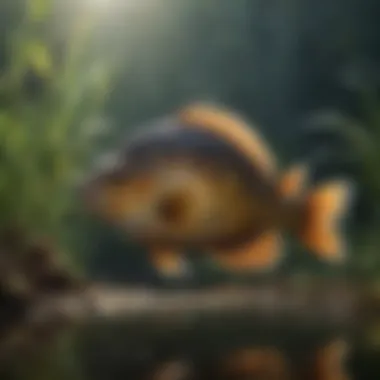
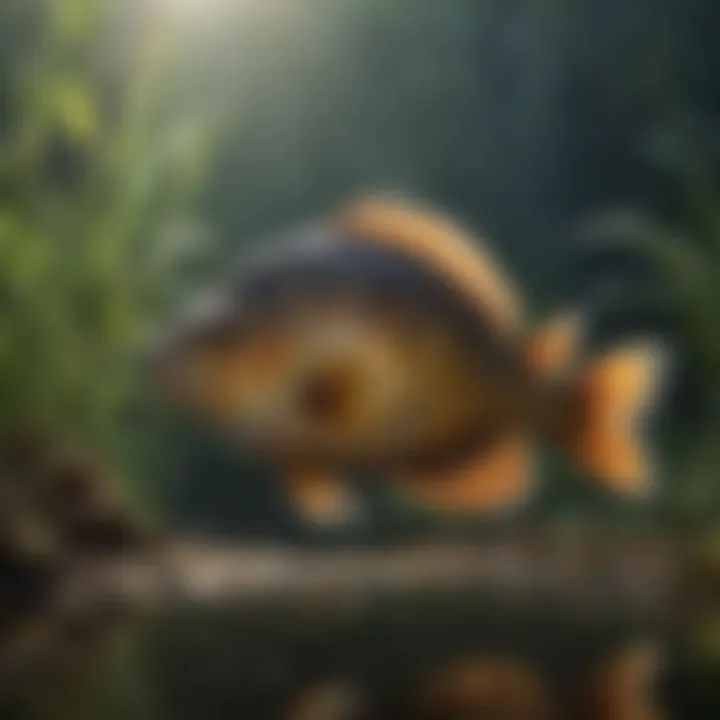
Spawning Behavior
The spawning behavior of panfish is both fascinating and critical to their reproductive success. Panfish typically spawn in spring or early summer when water temperatures rise to between 65°F and 75°F (18°C and 24°C). This behavior includes several important phases:
- Site Selection: Male panfish often select shallow waters with structures like rocks or submerged plants for nesting. This provides safety for the fry once they hatch.
- Nest Building: Males engage in nest-building activities, creating circular nests on the bottom substrate. This behavior is essential for attracting females.
- Courtship: Males display vibrant colors and unique movements to attract females. Courtship rituals can include rapid swimming and hovering near the nests.
- Fertilization: After females lay eggs in the nests, males will fertilize them, and both parents may provide some level of protection from predators.
Panfish show variable parental care, with some species being more protective than others. This care improves the survival rate of the young, shedding light on the significance of spawning behavior in population dynamics.
Understanding these behavioral patterns not only enhances our appreciation for panfish but also informs conservation strategies aimed at preserving their populations. Effective management relies on insights derived from observing these species in their natural contexts.
The Role of Panfish in Biodiversity
Panfish play a crucial part in maintaining biodiversity within freshwater ecosystems. Their presence supports many natural processes and creates a balanced environment. A deeper understanding of this role provides insight into their importance beyond recreational fishing. By examining how panfish interact with other species and contribute to ecosystem functionality, we can appreciate their ecological value.
Contribution to Ecosystem Stability
Panfish, such as bluegill and crappie, are not only a source of food for larger predators but also serve as a key component in the food web. This interconnectedness helps maintain the stability of aquatic environments.
- Nutrient Cycling: Panfish contribute to nutrient cycling by feeding on zooplankton and detritus. As they consume these organisms, they help in breaking down organic matter, releasing nutrients back into the water system. This process supports the overall health of aquatic plants.
- Population Control: Their feeding habits regulate populations of smaller fish and invertebrates, preventing any one species from dominating. This balances the ecosystem and promotes biodiversity.
- Habitat Modification: Panfish, especially during their spawning season, engage in behaviors that modify their habitats. They create nests that can benefit other species. This modification serves as a strategic move in ecosystem stability.
"The balance in an ecosystem often hinges on the roles played by various species, including panfish, which are often overlooked."
Predator-Prey Relationships
The relationships between panfish and the species that eat them, as well as those they consume, are intricate and vital to ecosystem health.
- Food Source for Predators: Panfish are an essential food source for larger fish, birds, and some mammals. By providing sustenance for these species, they are part of a larger food chain that helps sustain diverse wildlife.
- Predation Pressure: The presence of predators such as bass affects the behavior and distribution of panfish. This relationship controls panfish populations, contributing to their health and diversity.
- Contribution to Biodiversity: Through their interactions as both predators and prey, panfish help maintain a wide range of biodiversity in their habitats. When panfish populations thrive, they provide stability not just for themselves, but for entire communities of organisms.
Understanding the role of panfish in these ecosystems encourages informed conservation efforts. This recognition highlights both the threats they face and the benefits they offer, ultimately reminding us of the need to protect these vital species.
Conservation Challenges Facing Panfish
The conservation challenges facing panfish are multifaceted and require attention. Understanding these issues is vital not only for the survival of these species but also for the overall health of aquatic ecosystems. Each challenge presents unique problems that can significantly impact panfish populations. The importance of addressing these challenges lies in maintaining biodiversity and ensuring sustainable practices that protect these species for future generations.
Threats from Pollution
Pollution is one of the primary threats affecting panfish and their habitats. Various forms of pollution, such as agricultural runoff, industrial waste, and plastic debris, contaminate water bodies. These pollutants affect water quality, leading to higher levels of toxins in aquatic environments. As a result, the health of panfish declines, affecting their growth and reproduction. Harmful substances not only disrupt their breeding patterns but also filter into the food web, impacting the entire ecosystem.
Additionally, pollutants may cause habitat destruction. For example, excessive nutrients lead to algal blooms, which consume oxygen and create dead zones. This impact is especially pivotal in freshwater environments where panfish thrive.
Impact of Invasive Species
Invasive species present a considerable challenge to native panfish populations. These non-native species often outcompete panfish for food and habitat. For instance, the introduction of species such as the Zebra Mussel has led to significant reductions in resources for native fish. Invasive predators, such as the Northern Pike, pose further threats by preying on young panfish, reducing their chances of survival.
The competition and predation can disrupt the delicate balance of aquatic ecosystems. Native species often find it hard to adapt to the rapid changes caused by these invaders, leading to a decline in population. Such reductions can alter predator-prey dynamics, further destabilizing habitats integral to panfish.
Overfishing Concerns
Overfishing is another critical issue impacting panfish populations. As demand for recreational and commercial fishing rises, the pressure on these species increases. If fishing is not managed properly, it can lead to significant declines in panfish numbers. Many anglers may not follow sustainable practices, which can lead to excessive catching, especially during breeding seasons.
The impact of overfishing extends beyond the immediate loss of fish. It alters population structures, making it harder for species to recover. The removal of larger and breeding adults can hinder population regeneration, threatening the long-term survival of panfish. Sustainable fishing measures, including regulated seasons and catch limits, are vital to addressing this concern.
"Conserving panfish species requires a multifaceted approach, addressing pollution, invasive species, and overfishing to ensure their longevity in freshwater ecosystems."
By understanding these conservation challenges, we can better advocate for panfish and their habitats. Addressing these issues is crucial for the well-being of aquatic ecosystems and the numerous species, including humans, who rely on them.
Sustainable Fishing Practices
Sustainable fishing practices are vital for maintaining the delicate balance of aquatic ecosystems. These methods ensure that panfish populations are not only preserved but also thrive for future generations. By adopting sustainable practices, anglers contribute to the health of water bodies and the biodiversity of species within these habitats.
Catch and Release Strategies
Catch and release strategies play a crucial role in sustainable fishing. This method allows anglers to enjoy the sport of fishing while minimizing the impact on fish populations. Here are some key points about catch and release:
- Proper Handling: It is important to handle fish carefully to avoid injury. Wetting hands before touching fish helps protect their slime coatings, which are essential for their defense against disease.
- Quick Releases: Fishermen should try to minimize the time fish spend out of water. Every moment counts, as fish can struggle to survive if they are exposed to air for too long.
- Use Barbless Hooks: Using barbless hooks can decrease injury rates and make it easier to release fish.
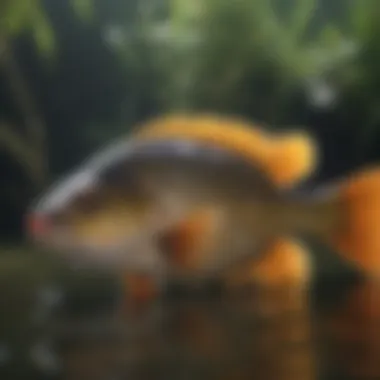
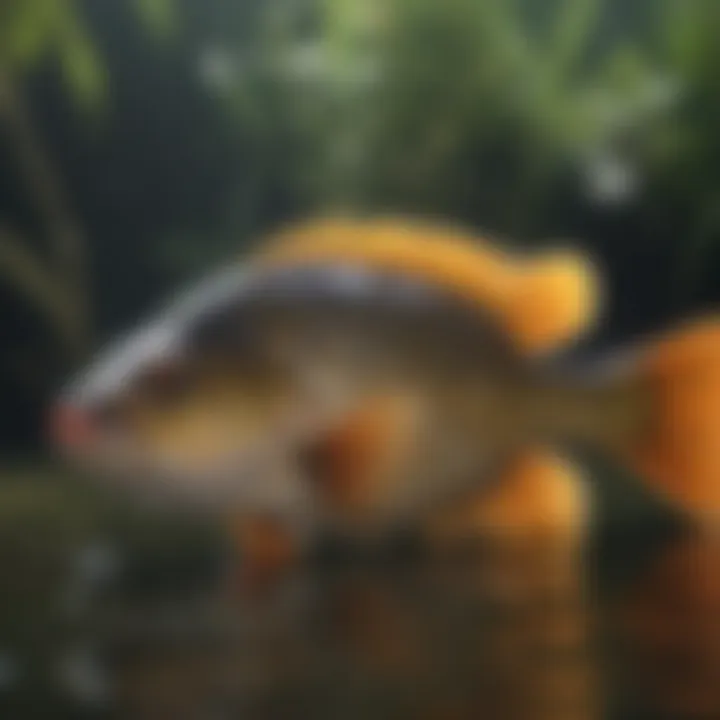
Implementing catch and release helps ensure that populations remain stable while allowing for recreational fishing activities.
Regulated Fishing Seasons
Regulated fishing seasons are another important component of sustainable fishing practices. These regulations help protect spawning periods, leading to healthier fish populations. Considerations for regulated seasons include:
- Spawning Cycles: Regulations take into account the biological cycles of different panfish species. Protecting spawning times allows fish to reproduce successfully, which is crucial for population sustainability.
- Species-Specific Regulations: Different species have varying requirements, so regulations are often tailored accordingly. For example, bluegill and crappie may have different open seasons to prevent overfishing during peak reproductive periods.
- Community Involvement: Involving local communities in setting these regulations fosters a sense of stewardship. Anglers need to understand the importance of adhering to these rules for preserving fisheries.
"Sustainable fishing practices are not just about regulations. They reflect a commitment to environmental integrity and future resource availability."
Through strategic regulation of fishing seasons, fish populations can recover and thrive, ultimately benefiting every stakeholder involved. Together, these practices underpin the sustainability of panfish and their ecosystems.
The Future of Panfish Populations
The future of panfish populatons is a topic that encompasses various scientific, environmental, and social dimensions. Understanding how these species might evolve over the coming years is crucial for conservation efforts and sustainable fishing practices. Research into panfish populations not only informs current strategies but also predicts potential challenges and opportunities. By analyzing various factors such as habitat conditions, climate change, and human activity, we can develop effective management approaches that sustain panfish populations for future generations.
Current Trends in Research
Current research trends focus on monitoring panfish populations through various scientific methods. These include population sampling, data analysis of growth rates, and habitat assessments. Studies show that environmental factors such as water temperature and quality significantly affect these fish's reproductive patterns and survival rates.
Additionally, genetic studies are providing insights into the adaptability of panfish species to changing climates. For example, scientists examine how specific gene variations within populations can influence resilience, particularly in environments facing pollution or habitat loss.
Collaborative efforts with universities and environmental organizations have increased funding for panfish research, leading to more comprehensive data collection. This cooperation enhances our understanding of the ecosystem dynamics involving panfish within freshwater environments. More precise insights are essential for encouraging practices that minimize human impacts on these populations.
Adaptive Management Strategies
Adaptive management strategies involve a systematic approach to improving resource management by learning from outcomes. These strategies are vital for the sustainability of panfish populations in various ecosystems.
One key aspect of adaptive management is flexibility. Policies and practices should evolve based on ongoing research findings. For example, if a certain fishing method is found to harm a specific panfish species, adjustments must be made to regulations immediately. Incorporating public feedback can also play a role in these strategies. Engaging local communities in decision-making processes ensures that their knowledge and experiences contribute to effective management.
Moreover, habitat restoration is another critical component. Protecting and restoring wetlands, lakes, and rivers directly support panfish populations. This involves active removal of invasive species that compete for resources. Efforts also include enhancing habitats by planting native vegetation that offers shelter and breeding grounds for panfish.
"Sustainable management of panfish species is not just about preserving them but also about maintaining the overall health of aquatic ecosystems."
Cultural and Economic Importance of Panfish
Panfish hold a significant place in various cultures and economies around the world. Their role goes beyond ecological balance; they are also essential to the livelihoods of many communities. Examining the cultural and economic importance of panfish reveals their multifaceted impact.
Panfish in Local Economies
Panfish contribute greatly to local economies, especially in regions where fishing is a prevalent activity. Not only do businesses rely on panfish, but many families also depend on them for sustenance and income. Small-scale fishermen often engage in catching bluegill and crappie, for example, to sell at local markets or serve in restaurants. This creates job opportunities in various sectors, including fishing gear stores, transportation services, and food production companies.
Moreover, some towns organize festivals centered around panfish, celebrating local fishing heritage. These events can attract tourism, stimulating further economic growth. Communities benefit from increased visitors, which can lead to a higher demand for accommodations, food services, and local merchandise.
Recreational Fishing Perspectives
Panfish offer excellent opportunities for recreational fishing. Many anglers appreciate the accessibility and abundance of species like bluegill and pumpkinseed. These fish are not only relatively easy to catch, but they also provide a rewarding experience for both novice and seasoned fishermen. This makes panfishing a popular family activity, fostering connections with nature.
The recreational aspect of panfish fishing is more than just a pastime. It supports conservation awareness as anglers learn about responsible fishing practices and the importance of preserving aquatic habitats. Many organizations advocate for catch-and-release practices, promoting sustainable fishing that allows fish populations to thrive while ensuring future generations can enjoy the sport.
"Angling has a deep connection to both culture and economy, intertwining recreation with conservation goals."
To summarize, panfish play a critical role in local economies through commercial fishing and tourism. Their significance in recreational fishing further highlights their importance to cultural identity and sustainable practices. Engaging with panfish not only supports economic stability but also enhances community awareness of environmental issues, making them essential in both social and economic contexts.
Epilogue
The conclusion section is critical to reinforce the findings presented in the article. It encapsulates the essence of the discussion regarding panfish species and emphasizes their ecological importance. The summary provides clarity, reminding readers of why understanding these species matters to both the environment and our activities.
Summary of Key Points
The following points summarize the main takeaways from this article:
- Definition and Characteristics: Panfish are notable for their diverse characteristics, making them essential for freshwater ecosystems.
- Ecological Role: These species contribute to aquatic biodiversity and serve as significant indicators of ecological health.
- Conservation Challenges: Pollution, invasive species, and overfishing pose serious threats to panfish populations.
- Sustainable Practices: Highlighting methods such as catch and release is vital for ensuring the long-term viability of panfish species.
- Cultural and Economic Impact: Panfish are not only ecologically significant but also economically important, contributing to local economies and recreational fishing.
Call to Action for Conservation Efforts
It is essential for individuals, communities, and organizations to join forces in conservation efforts aimed at protecting panfish species. Actions can include:
- Education Initiatives: Raising awareness about the ecological roles of panfish can foster a culture of conservation among anglers and environmentalists.
- Supporting Regulations: Advocacy for sustainable fishing laws is crucial to balancing recreational needs and ecosystem health.
- Community Involvement: Local initiatives for clean-up drives and habitat restoration can directly improve the habitats enjoyed by panfish.
- Research Participation: Encouraging participation in fish monitoring programs helps contribute to data collection and better management decisions.
In summary, understanding and protecting panfish species is an ongoing journey that requires collective action. Their role in ecosystems is intricately linked to our actions, and hence proactive efforts in conservation should be a priority for all stakeholders.



